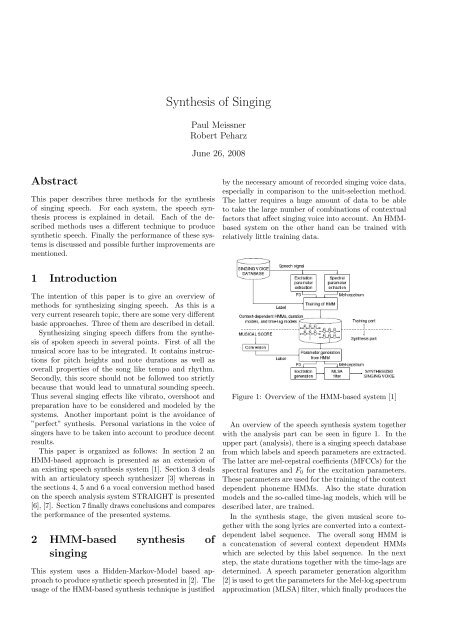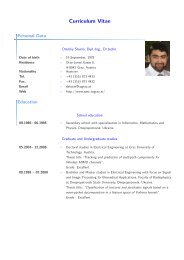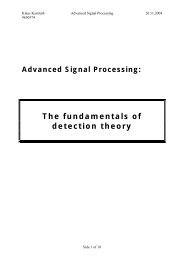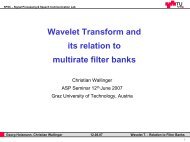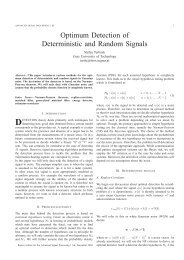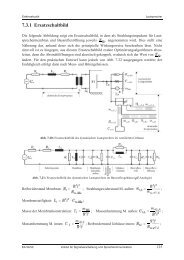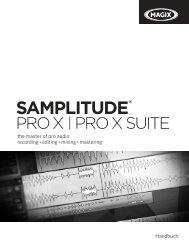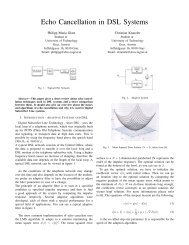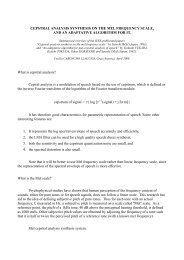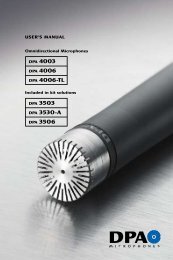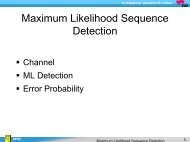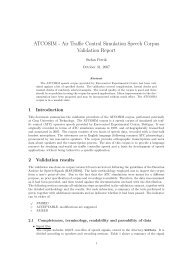Synthesis of Singing - SPSC
Synthesis of Singing - SPSC
Synthesis of Singing - SPSC
Create successful ePaper yourself
Turn your PDF publications into a flip-book with our unique Google optimized e-Paper software.
<strong>Synthesis</strong> <strong>of</strong> <strong>Singing</strong><br />
Paul Meissner<br />
Robert Peharz<br />
June 26, 2008<br />
Abstract<br />
This paper describes three methods for the synthesis<br />
<strong>of</strong> singing speech. For each system, the speech synthesis<br />
process is explained in detail. Each <strong>of</strong> the described<br />
methods uses a different technique to produce<br />
synthetic speech. Finally the performance <strong>of</strong> these systems<br />
is discussed and possible further improvements are<br />
mentioned.<br />
by the necessary amount <strong>of</strong> recorded singing voice data,<br />
especially in comparison to the unit-selection method.<br />
The latter requires a huge amount <strong>of</strong> data to be able<br />
to take the large number <strong>of</strong> combinations <strong>of</strong> contextual<br />
factors that affect singing voice into account. An HMMbased<br />
system on the other hand can be trained with<br />
relatively little training data.<br />
1 Introduction<br />
The intention <strong>of</strong> this paper is to give an overview <strong>of</strong><br />
methods for synthesizing singing speech. As this is a<br />
very current research topic, there are some very different<br />
basic approaches. Three <strong>of</strong> them are described in detail.<br />
Synthesizing singing speech differs from the synthesis<br />
<strong>of</strong> spoken speech in several points. First <strong>of</strong> all the<br />
musical score has to be integrated. It contains instructions<br />
for pitch heights and note durations as well as<br />
overall properties <strong>of</strong> the song like tempo and rhythm.<br />
Secondly, this score should not be followed too strictly<br />
because that would lead to unnatural sounding speech.<br />
Thus several singing effects like vibrato, overshoot and<br />
preparation have to be considered and modeled by the<br />
systems. Another important point is the avoidance <strong>of</strong><br />
”perfect” synthesis. Personal variations in the voice <strong>of</strong><br />
singers have to be taken into account to produce decent<br />
results.<br />
This paper is organized as follows: In section 2 an<br />
HMM-based approach is presented as an extension <strong>of</strong><br />
an existing speech synthesis system [1]. Section 3 deals<br />
with an articulatory speech synthesizer [3] whereas in<br />
the sections 4, 5 and 6 a vocal conversion method based<br />
on the speech analysis system STRAIGHT is presented<br />
[6], [7]. Section 7 finally draws conclusions and compares<br />
the performance <strong>of</strong> the presented systems.<br />
2 HMM-based synthesis <strong>of</strong><br />
singing<br />
This system uses a Hidden-Markov-Model based approach<br />
to produce synthetic speech presented in [2]. The<br />
usage <strong>of</strong> the HMM-based synthesis technique is justified<br />
Figure 1: Overview <strong>of</strong> the HMM-based system [1]<br />
An overview <strong>of</strong> the speech synthesis system together<br />
with the analysis part can be seen in figure 1. In the<br />
upper part (analysis), there is a singing speech database<br />
from which labels and speech parameters are extracted.<br />
The latter are mel-cepstral coefficients (MFCCs) for the<br />
spectral features and F 0 for the excitation parameters.<br />
These parameters are used for the training <strong>of</strong> the context<br />
dependent phoneme HMMs. Also the state duration<br />
models and the so-called time-lag models, which will be<br />
described later, are trained.<br />
In the synthesis stage, the given musical score together<br />
with the song lyrics are converted into a contextdependent<br />
label sequence. The overall song HMM is<br />
a concatenation <strong>of</strong> several context dependent HMMs<br />
which are selected by this label sequence. In the next<br />
step, the state durations together with the time-lags are<br />
determined. A speech parameter generation algorithm<br />
[2] is used to get the parameters for the Mel-log spectrum<br />
approximation (MLSA) filter, which finally produces the
2 HMM-BASED SYNTHESIS OF SINGING<br />
synthetic speech.<br />
The system is very similar to an HMM-based reading<br />
speech synthesizing system presented in [2]. However,<br />
there are two main differences in the synthesis <strong>of</strong> singing:<br />
Contextual factors and the time-lag models, which will<br />
be described in the next subsections.<br />
2.1 Contextual factors<br />
According to [1], the contextual factors that affect<br />
singing voice should be different from those that affect<br />
reading voice. The presented method uses the following<br />
contextual factors:<br />
Determination <strong>of</strong> these time-lags is in principle analogous<br />
to the other speech parameters like pitch and state<br />
duration: There is a context-clustering using a decision<br />
tree. Context dependent labels are assigned to the<br />
time-lags and so they can be selected. Like the state<br />
duration models, the time-lag models are in fact just<br />
one-dimensional Gaussians. The process can be seen in<br />
figure 3.<br />
• Phoneme<br />
• Tone (as indicated by the musical notes)<br />
• Note duration and<br />
• Position in the current musical bar<br />
For each <strong>of</strong> these factors, the preceding, succeeding<br />
and current one is taken into account. These factors<br />
are determined automatically from the musical score,<br />
however the paper does not go into detail about that.<br />
2.2 Time-lag models<br />
The time-lag models seem to be the main feature <strong>of</strong><br />
this method. Their principal purpose can be explained<br />
in the following way: If a singing voice is synthesized<br />
that exactly follows the instructions given by the musical<br />
score, the result will sound unnatural. This is due to<br />
the fact that no human singer will ever strictly follow<br />
the score. There are always variations in any <strong>of</strong> the<br />
parameters and the time-lag models take variations in<br />
the note timing into account.<br />
Figure 3: Decision tree clustering <strong>of</strong> the time-lag models<br />
[1]<br />
At the synthesis stage, the concrete time-lags have to<br />
be determined. This is done by firstly taking each note<br />
duration from the musical score. Secondly, the state<br />
durations and time-lags are determined simultaneously<br />
such that their joint probability is maximized:<br />
P (d, g|T, Λ) = P (d|g, T, Λ)P (g|Λ) (1)<br />
N∏<br />
= P (d k |T k , g k , g k−1 , Λ)P (g k |Λ)<br />
k=1<br />
Figure 2: Usage <strong>of</strong> time-lag models [1]<br />
The effect can be seen in figure 2. Time-lags are<br />
placed between the start <strong>of</strong> the notes given by the score<br />
and the start <strong>of</strong> the actual speech. The authors mention<br />
for example the well-known tendency <strong>of</strong> human singers<br />
to start consonants a little earlier than indicated by the<br />
score [1].<br />
where d k are the start durations <strong>of</strong> the k th note, g k is the<br />
time-lag <strong>of</strong> the start timing <strong>of</strong> the k + 1 th note and T k is<br />
the duration <strong>of</strong> the k th note from the score. Finding the<br />
values <strong>of</strong> d and g that maximize this probability leads<br />
to a set <strong>of</strong> linear equations that can be solved quite<br />
efficiently.<br />
2.3 Experimental evaluation<br />
The authors say that they could not find a suitable and<br />
available singing voice database, so they recorded one<br />
by themselves for which they took a non-pr<strong>of</strong>essional<br />
2
3 ARTICULATORY SYNTHESIS OF SINGING<br />
japanese singer. Manual corrections were done to enhance<br />
the quality. Speech analysis, HMM training and<br />
context clustering were performed. A subjective listening<br />
test was performed where they took 14 test persons<br />
and played them 15 randomly selected musical phrases<br />
synthesized with their system. An important result was<br />
that the incorporation <strong>of</strong> the time-lag models substantially<br />
improved the perceived speech quality. The test<br />
persons also found that the voice characteristics <strong>of</strong> the<br />
original singer were found in the synthetic speech. An<br />
example for this is that the original singer had the tendency<br />
to sing a little too flat, which was reflected by the<br />
synthesized F 0 -pattern.<br />
3 Articulatory synthesis <strong>of</strong><br />
singing<br />
This method, which is described in [3] and [4], uses<br />
a completely different approach to synthesize speech<br />
sounds. Like the HMM-based system from the previous<br />
section, it is also an extension <strong>of</strong> an already existing<br />
speech synthesizer that was modified to be able to produce<br />
singing speech. This was done for the synthesis <strong>of</strong><br />
singing challenge at the Interspeech 2007 in Antwerp,<br />
Belgium [5].<br />
This method consists <strong>of</strong> a comprehensive threedimensional<br />
model <strong>of</strong> the vocal tract together with additional<br />
steps and other models to simulate this model<br />
in order to get speech sounds out <strong>of</strong> it. The geometric<br />
model is converted into an acoustic branched tube model<br />
and finally to an electric transmission line circuit. Another<br />
interesting feature is the way how this method is<br />
controlled. All these points are explained in more detail<br />
in the following subsections.<br />
3.1 Overview <strong>of</strong> the synthesizer<br />
Figure 4 shows an overview <strong>of</strong> the articulatory speech<br />
synthesizer [3]. On top, the input to the system is missing<br />
but that will be described later. The system consists<br />
<strong>of</strong> three parts: The three-dimensional wireframe<br />
vocal tract representation (upper part <strong>of</strong> the figure),<br />
the acoustic branched tube model (middle part) and<br />
the simulated electrical transmission line circuit (lower<br />
part).<br />
Shape and position <strong>of</strong> all movable structures in the<br />
vocal tract model are a function <strong>of</strong> 23 parameters, like<br />
horizontal tongue position or lip opening for example.<br />
To create the wireframe model, magnetic resonance images<br />
(MRI) <strong>of</strong> a german male speaker were taken during<br />
the pronunciation <strong>of</strong> each german vowel and consonant.<br />
This MRI data was used to find the parameter combinations.<br />
It is well-known that vowels and consonants do<br />
not stand for themselves concerning their articulation.<br />
There is the important topic <strong>of</strong> coarticulation. If you for<br />
Figure 4: Overview <strong>of</strong> the articulatory synthesizer [3]<br />
example say the german utterances ”igi” and ”ugu” you<br />
will find out that your vocal tract behaves differently<br />
for both times you pronounce the consonant g. Your<br />
tongue will be raised both times, so the vertical tongue<br />
position is likely to be important for the pronunciation<br />
<strong>of</strong> a g. The horizontal tongue position however is different:<br />
For the ”igi”, the tongue will be more in front <strong>of</strong><br />
the mouth than it is for the ”ugu”. So the horizontal<br />
tongue position for a g is an example for coarticulation,<br />
some parameters <strong>of</strong> the vocal tract depend on surrounding<br />
vowels or consonants. This method takes this into<br />
account by a so-called dominance model [4], which consists<br />
<strong>of</strong> a weighting <strong>of</strong> the vocal tract parameters for<br />
consonants and vowels. A high weight means that the<br />
corresponding parameter is important for this letter, a<br />
low weight indicates coarticulation.<br />
The next step is the acoustical simulation <strong>of</strong> the model<br />
via a branched tube model that represents the vocal<br />
tract geometry. It consists <strong>of</strong> short adjacent elliptical<br />
tube sections which can be represented by an overall<br />
area function (see figure 4, middle part) and a discrete<br />
perimeter function.<br />
This tube model can be transformed into an inhomogeneous<br />
transmission line circuit with lumped elements<br />
(see figure 4, lower part). This is done by using an analogy<br />
between acoutic and electric transmission that both<br />
deal with wave propagation along a path where there are<br />
impedance changes. Each <strong>of</strong> the tube sections is repre-<br />
3
3 ARTICULATORY SYNTHESIS OF SINGING<br />
sented with a two-port T-type network, whose elements<br />
are a function <strong>of</strong> the tube geometry. Speech output is<br />
produced by simulating this network by means <strong>of</strong> finite<br />
difference equations in time domain. Many additional<br />
effects that can occur in the vocal tract are taken into<br />
account by making the electrical network more complex.<br />
There are for example parallel circuits for the paranasal<br />
sinus or parallel chinks in the vocal tract. The author<br />
says that all major speech sound for German are possible<br />
with this method [3].<br />
3.2 Gestural score<br />
In figure 4, the overall input to the system was missing.<br />
Utterances can be produced by certain combinations<br />
and movements <strong>of</strong> 23 vocal tract parameters but<br />
until now there is no way <strong>of</strong> controlling these parameters.<br />
The author developed a method called gestural score [3],<br />
[4] which fills the gap between musical score and lyrics<br />
on the one hand and the vocal tract parameters at the<br />
other hand. It is important to mention that this gestural<br />
score does not contain the vocal tract target parameters<br />
themselves, but are used for their generation. The author<br />
calls them ”goal-oriented ariculatory movements”<br />
[4], so they more or less show what has to be done by<br />
the vocal tract, but not how.<br />
use very similar vocal tract shapes. The group (b,p,m)<br />
is an example for this. These consonants are produced<br />
by a common vocal tract configuration with minor variations.<br />
The second conspicuity is the overlapping <strong>of</strong><br />
consonants and vowels. This is again due to the coarticulation<br />
phenomenon mentioned in section 3.1.<br />
The other four gestural score types are the targets<br />
for velic aperture, glottal area, target F 0 and lung pressure.<br />
Below those there are two examples <strong>of</strong> concrete<br />
vocal tract parameters, the lip opening and the tongue<br />
tip height. These are generated from the gestural score<br />
and are target functions for the vocal tract parameters.<br />
They are realized using critically damped, third-order<br />
dynamical systems with the transfer function:<br />
H(s) =<br />
1<br />
(1 + τs) 3 (2)<br />
where τ is a time constant which can be used to control<br />
the speed <strong>of</strong> the parameter change.<br />
The author derives the gestural score by using a rulebased<br />
transformation <strong>of</strong> a self-defined XML-format that<br />
represents a song including its score and lyrics.<br />
3.3 Pitch dependent vocal tract target<br />
shapes<br />
It is well-known that singers use different vocal tract<br />
shapes for the same vowel at different pitches. The original<br />
articulatory speech synthesizer did not take this into<br />
account and used just one general target shape. Figure<br />
6 explains the occurring effects.<br />
Figure 5: Gestural score with an example [4]<br />
The way this gestural score works is explained by an<br />
example given in figure 5, the german utterance ”musik”<br />
[4]. Below the speech signal there are six rows, which<br />
correspond to the six types <strong>of</strong> gestural scores. The first<br />
two are simply vocalic, in this case the u and i and consonantal<br />
gestures, here m, s and k. At the first glance it<br />
is striking that there seem to be the wrong consonants,<br />
but it is well-known that certain groups <strong>of</strong> consonants<br />
Figure 6: Pitch dependent vocal tract target shapes [3]<br />
4
5 STRAIGHT<br />
The solid line in the graphs represents the vocal tract<br />
transfer function and the spectral lines are the harmonics<br />
<strong>of</strong> the voice source. The first <strong>of</strong> the three graphs<br />
shows these for an /i:/, sung at F 0 = 110 Hz and the<br />
conventional, low pitch vocal tract shape (on the upper<br />
left). If that /i:/ is produced by the same vocal tract<br />
shape, but at F 0 = 440 Hz, this will result in the second<br />
graph that is shown. One can clearly see that the first<br />
formant <strong>of</strong> the vocal tract does not match the first formant<br />
<strong>of</strong> the voice source at all. To overcome this problem,<br />
a second, high-pitch (440 Hz) target shape, shown<br />
on the upper right, was created. So this and the conventional<br />
(110 Hz) shape are the two ”extreme” target<br />
shapes. The lowest graph in figure 6 shows the highpitch<br />
/i:/ with the high-pitch shape. Here one can see<br />
that the first harmonic <strong>of</strong> the source and the first vocal<br />
tract formant match well.<br />
Between these two vocal tract shapes, a linear interpolation<br />
is performed.<br />
modification methods. In its first version, it consists<br />
<strong>of</strong> a robust and accurate F0 estimator and a spectral<br />
representation cleaned from distortions which normally<br />
occur in the standard spectrogram.<br />
5.1 Principle<br />
The STRAIGHT system is derived from the channel<br />
vocoder, which is illustrated in figure 7. The channel<br />
vocoder detects whether the input signal x(k) is voiced<br />
or unvoiced and encodes this information in a binary<br />
variable S. If the input signal is voiced, the F0 (N0) is extracted,<br />
normally by measuring the fundamental period.<br />
Additionally, the input is processed by a band pass filter<br />
bank with central frequencies covering the frequency<br />
range <strong>of</strong> x(k). After each band pass filter, the envelope<br />
<strong>of</strong> the channel signal is determined giving a gain factor<br />
for each channel.<br />
3.4 Evaluation<br />
Articulatory speech synthesis is a very interesting approach<br />
to speech synthesis in general, because it reflects<br />
the natural way speech is produced. At the synthesis <strong>of</strong><br />
singing challenge 2007, this method finished at the second<br />
place [5] out <strong>of</strong> six contestants. It is also worth mentioning<br />
that this method seems to need a lot <strong>of</strong> manual<br />
fine tuning, especially for optimizing vocal tract shapes.<br />
The author also mentions the guidance <strong>of</strong> this fine tuning<br />
by a pr<strong>of</strong>essional singer as one possible future improvement.<br />
4 Converting Speech into <strong>Singing</strong><br />
Voice<br />
The method <strong>of</strong> the winner <strong>of</strong> the <strong>Synthesis</strong> <strong>of</strong> <strong>Singing</strong><br />
Contest 2007 [5], [6] is presented. The main idea here<br />
is to analyse a speaking voice reading the lyrics <strong>of</strong> song<br />
and to convert it to a singing voice by adapting the<br />
speech parameters according to a musical score and some<br />
know-how about singing voices. The speaking voice is<br />
analysed by a system called STRAIGHT. After adapting<br />
the parameters to represent a singing voice, they<br />
are re-synthesised. The next section describes the basic<br />
ideas <strong>of</strong> STRAIGHT, the main tool used here. Then the<br />
conversion system is discussed in more detail.<br />
5 STRAIGHT<br />
STRAIGHT stands for ”Speech Transformation<br />
and Representation using Adaptive Interpolation <strong>of</strong><br />
weighted Spectrum” and was proposed by Kawahara<br />
et al. [7]. The idea for STRAIGHT was introduced by<br />
the need for flexible and robust speech analysis and<br />
Figure 7: Channel vocoder<br />
On the receiving side <strong>of</strong> the channel vocoder, an artificial<br />
excitation signal is generated from S and N0. This<br />
excitation is processed by an identical filter bank like on<br />
the transmitting side and amplified by the gain factors.<br />
The gain factors together with the filter bank model the<br />
vocal tract in the well known source-filter model (figure<br />
8) widely used in speech processing. Note that a bandpass<br />
<strong>of</strong> the filter bank can be seen as a modulated version<br />
<strong>of</strong> a prototype low-pass, if the shapes <strong>of</strong> the band-passes<br />
are identical. Further the filter bank can be described in<br />
terms <strong>of</strong> <strong>of</strong> the Short Term Fourier Transform (STFT)<br />
using the impulse response <strong>of</strong> the prototype low-pass as<br />
windowing function [8]. In that way, the power spectrogram<br />
models the vocal tract filter.<br />
The advantages <strong>of</strong> the channel vocoder are the simple<br />
and easy to understand concept, the intelligible speech<br />
quality and a robust possibility to change speech param-<br />
5
5 STRAIGHT<br />
Figure 8: Source-filter model<br />
eters.<br />
The disadvantage is that the vocoder produces bad<br />
quality in sense <strong>of</strong> naturalness. A normal vocoder voice<br />
sounds mechanic and robot like. In some cases this desired.<br />
For example, it is a nice effect used in computer<br />
music to take the signal <strong>of</strong> an instrument as excitation <strong>of</strong><br />
the vocal tract filter. The instrument still can be heard<br />
clearly, but it is coloured by the singing voice. As an<br />
example hear the song ”Remember” by the group Air.<br />
However, the typical vocoder voice is not desired if the<br />
goal is natural sounding synthesised speech.<br />
5.2 Spectrogram Smoothing<br />
One <strong>of</strong> the main problems <strong>of</strong> the vocoder is a certain<br />
buzziness when the excitation is plosive. There are already<br />
affective approaches to reduce this problem. The<br />
other problem are interferences in the estimation <strong>of</strong><br />
the spectrogram, introduced by periodic excitations, i.e.<br />
voiced sounds. In the Vocoder concept, the estimation<br />
<strong>of</strong> spectrogram is equivalent to the identification <strong>of</strong> the<br />
vocal tract filter. It is clear, that this identification is<br />
easier if a noise like input signal, i.e. unvoiced sounds,<br />
is used. However, if the excitation is quasi-periodic, the<br />
spectrogram exhibits interferences, which appear as periodic<br />
distortions in the time domain and in the frequency<br />
domain. Therefore information <strong>of</strong> F0 and the<br />
window length is visible in the whole spectrogram and<br />
a clean separation <strong>of</strong> excitation and vocal tract is not<br />
achieved.<br />
The solution proposed by Kawahara et al. is to regard<br />
the periodic excitation signal as 2 dimensional sampling<br />
operator, which provides information every t0 and F0.<br />
Due to this, the spectrogram can be seen as 3D surface,<br />
where time and frequency are on the abscissae and the<br />
power is on the ordinate. In that way, spectral analysis<br />
can be seen as a surface recovery problem. The<br />
first approach proposed by the authors was to use a<br />
2D smoothing kernel, which is computational intensive.<br />
The next approach they presented was to reduce the recovery<br />
problem to one dimension. If the window <strong>of</strong> the<br />
STFT matches the current fundamental period <strong>of</strong> the<br />
signal, the variations in the time domain are eliminated<br />
and the surface reconstruction problem is reduced to the<br />
frequency domain. For that, an exact and robust F0 estimator<br />
is needed, and will be discussed later as part <strong>of</strong><br />
the STRAIGHT strategy.<br />
The easiest method to recover the 1 dimensional frequency<br />
surface is to connect the frequency pins with<br />
straight line segments. An equivalent approach which<br />
is more robust against F0 estimation errors, is the convolution<br />
with a smoothing kernel. Luckily, convolution<br />
in frequency domain is equivalent to multiplication in<br />
time domain and can be achieved by selecting an appropriate<br />
form <strong>of</strong> the pitch adaptive time window. The<br />
authors chose a triangular window, since it corresponds<br />
to a (sin(x)/x) 2 function in frequency domain and places<br />
zeros on all harmonic pins except the pin at 0. In addition,<br />
the triangular window is weighted with a Gaussian<br />
window to further suppress F0 estimation errors.<br />
Figure 10: Spectrogram <strong>of</strong> pulse train using pitch adaptive<br />
windows<br />
In figure 10 one can see that this operation eliminates<br />
the periodic interferences. One can also see phasic extinctions<br />
<strong>of</strong> adjacent harmonic components, visible as<br />
holes in spectral valleys. In order to reduce these, a<br />
complementary spectrogram is computed by modulating<br />
the original window in the form<br />
Figure 9: Spectrogram <strong>of</strong> a regular pulse train with interferences<br />
w c (t) = w(t)sin(πt/t 0 ) (3)<br />
The resulting spectrogram has peaks where the original<br />
spectrogram has holes, as it can be seen in figure<br />
11. The spectrogram with reduced phase extinctions<br />
6
6 APPLICATION IN THE SPEECH TO SINGING VOICE SYSTEM<br />
in figure 12 is created by blending the original and the<br />
complementary spectrogram in the form <strong>of</strong><br />
P r (w, t) = √ P 0 (w, t) 2 + ξP C (w, t) 2 (4)<br />
The blending factor ξ was determined by a numerical<br />
search method and set to 0.13655.<br />
Figure 11: Complementary spectrogram<br />
s(t) = ∑ (∫ t<br />
)<br />
α k (t)sin k(ω(τ) + ω k (τ))dτ + Φ k<br />
k∈N<br />
t0<br />
(5)<br />
The STRAIGHT method uses a new concept called<br />
”fundamentalness” for the F0 estimation. For this purpose,<br />
the input signal is split into frequency channels,<br />
where a special shaped filter is used. This procedure is<br />
illustrated in figure 13. Note that the filter has a steeper<br />
edge at higher frequencies and a slower cut-<strong>of</strong>f at lower<br />
frequencies. This shape can contain the fundamental<br />
component alone, but will contain lower components if<br />
it is moved over higher components. The fundamentalness<br />
for each channel is defined as the reciprocal <strong>of</strong> the<br />
product <strong>of</strong> the FM and the AM components, where the<br />
AM component is normalized by the total energy and<br />
the FM component is normalized by the squared frequency<br />
<strong>of</strong> the channel. Therefore, the fundamentalness<br />
<strong>of</strong> a channel is high, if the FM and AM magnitudes are<br />
low. The F0 is determined by averaging the instantaneous<br />
frequencies <strong>of</strong> the channel with the highest fundamentalness<br />
index and its neighbouring channels. The<br />
fundamentalness was found to be a good estimator for<br />
F0 even at low SNR. Also, a reciprocal relation between<br />
the fundamentalness value and the estimation error <strong>of</strong><br />
F0 was observed. Due to this, the fundamentalness can<br />
also be used for the voiced/unvoiced decision.<br />
Figure 12: Blended spectrogram<br />
One problem introduced by the method described<br />
here is over-smoothing. Using the pitch adaptive triangular<br />
window weighted with a Gaussian window is<br />
equivalent to apply a Gaussian smoothing kernel followed<br />
by a (sin(x)/x) 2 -kernel in the frequency domain.<br />
This over-smooths the underlying spectral information.<br />
To overcome this problem, Kawahara et al. modified the<br />
triangular kernel using an inverse filter technique. The<br />
new kernel reduced the over-smoothing effect while still<br />
aiming at the goal to recover spectral information in the<br />
frequency domain [7].<br />
Figure 13: Illustration <strong>of</strong> fundamentalness<br />
5.3 F0 Estimation<br />
Normally the F0 is estimated by detecting the fundamental<br />
period. This approach is hard for speech signals,<br />
since they are not purely periodic and their F0 is unstable<br />
and time variant. The following representation <strong>of</strong> a<br />
speech waveform is used, which is a superposition <strong>of</strong> amplitude<br />
modulated and frequency modulated sinusoids<br />
6 Application in the Speech to<br />
<strong>Singing</strong> Voice system<br />
The overall system is sketched in figure 14 [6]. The<br />
speaking voice signal and the musical score including<br />
the song lyrics are inputs to the system. Additionally,<br />
synchronization information between these has to<br />
7
7 CONCLUSION<br />
be provided, which is created by hand in the current<br />
system (see figure 15). STRAIGHT extracts the F0, the<br />
spectral envelope and a time-frequency map <strong>of</strong> aperiodicity,<br />
which is a concept introduced in later versions<br />
<strong>of</strong> STRAIGHT. These parameters are changed in three<br />
ways: change <strong>of</strong> the F0, change <strong>of</strong> the duration and<br />
change <strong>of</strong> the spectral information.<br />
Figure 15: Synchronisation information<br />
empirically. The boundary part is kept unchanged and<br />
the vowel part is lengthened, so that the whole combination<br />
fills the desired note length.<br />
Figure 14: Overall conversion system<br />
6.1 F0<br />
The ideal F0 <strong>of</strong> the singing voice is completely given by<br />
the musical score (see figure 16). Following the pitch<br />
exactly would sound very unnatural. Therefore the F0<br />
is changed according to features observed in real singing<br />
voices. Firstly, overshoot is added, which is a exceeding<br />
over the target note after a jump. Secondly, a vibrato is<br />
simulated by a 4-7 Hz frequency modulation. Thirdly,<br />
a movement <strong>of</strong> pitch in opposite direction just before a<br />
jump is added, which is called preparation. Fourthly,<br />
fine fluctuations (>10 Hz) in F0 are modeled by adding<br />
low-pass filtered noise.<br />
6.2 Duration<br />
The duration <strong>of</strong> the spoken words has to be adapted to<br />
the duration <strong>of</strong> sung words, given by the musical score.<br />
A consonant followed by a vowel is modelled as a consonant<br />
part, a boundary part <strong>of</strong> 40ms and a vowel part.<br />
The consonant parts are lengthened by fixed rates, dependent<br />
on the consonant type. These rates were found<br />
Figure 16: F0 changes<br />
6.3 Spectral Envelope<br />
Different than in speech voices, in singing voices a strong<br />
peak can be observed at about 3kHz, a so-called singing<br />
formant. In the conversion system, this peak is emphasised<br />
in the spectrogram. Another feature the authors<br />
implemented is an AM <strong>of</strong> the formants synchronized<br />
with the vibrato <strong>of</strong> the F0, which also occurs in real<br />
singing voices.<br />
7 Conclusion<br />
This paper described three very different methods <strong>of</strong><br />
synthesizing singing voice. In particular, the underlying<br />
8
REFERENCES<br />
References<br />
[1] Keijiro Saino, Heiga Zen, Yoshihiko Nankaku,<br />
Akinobu Lee, Keiichi Tokuda: ”An HMM-based<br />
<strong>Singing</strong> Voice <strong>Synthesis</strong> System”, 2006<br />
[2] Takayoshi Yoshimura, Keiichi Tokuda, Takashi Masuko,<br />
Takao Kobayashi, Tadashi Kitamura: ”Simultaneous<br />
Modeling <strong>of</strong> Spectrum, Pitch and Duration<br />
in HMM-based Speech <strong>Synthesis</strong>”, 1999<br />
[3] Peter Birkholz: ”Articulatory <strong>Synthesis</strong> <strong>of</strong><br />
<strong>Singing</strong>”, 2007<br />
[4] Peter Birkholz, Ingmar Steiner, Stefan Breuer:<br />
”Control Concepts for Articulatory Speech <strong>Synthesis</strong>”,<br />
2007<br />
[5] http://www.interspeech2007.org/Technical/<br />
synthesis_<strong>of</strong>_singing_challenge.php, 2007<br />
[6] Takeshi Saitou, Masataka Goto, Masashi Unoki,<br />
Masato Akagi: ”Vocal Conversion from Speaking<br />
Voice to <strong>Singing</strong> Voice Using STRAIGHT”, 2007<br />
Figure 17: Original and modified spectrogram<br />
techniques <strong>of</strong> speech synthesis were presented, together<br />
with the necessary extensions to produce singing voice.<br />
The choice <strong>of</strong> the presented methods was made according<br />
to their relevance. From the synthesis <strong>of</strong> singing<br />
challenge 2007 [5], the first- and second-placed participants<br />
were considered as well as an example for HMMbased<br />
singing synthesis. The latter one was chosen because<br />
it can be understood as an extension <strong>of</strong> a speech<br />
synthesis system that was presented earlier.<br />
In general, current methods show a surprisingly good<br />
performance, although there are many situations in<br />
which a still too artificial sounding output is produced.<br />
Here, the goal has to be naturalness. Therefore, typical<br />
variations in all voice parameters have to be taken into<br />
account.<br />
[7] Hideki Kawahara, Ikuyo Masuda-Katsuse, Alain<br />
de Cheveigné: ”Restructuring speech representations<br />
using a pitch adaptive time-frequency smoothing<br />
and an instantaneous-frequency-based F0 extraction:<br />
Possible role <strong>of</strong> a repetitive structure in<br />
sounds”, Speech Commun., Vol. 27, pp. 187-207,<br />
1998<br />
[8] Peter Vary, Rainer Martin: ”Digital Speech Transmission”,<br />
Wiley, 2006<br />
9


